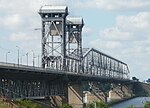Lift bridge
A lifting bridge or lifting bridge is a movable bridge in which a greater clearance is created for ships by lifting the driveway. The track or the track carrier is moved upwards in a horizontal position with the aid of hydraulics or spindle drives . In contrast to bascule bridges , the clearance height of lift bridges is limited by the lift height.
The South Halsted Street Lift Bridge in Chicago , Illinois , opened in 1894 , was the world's first lift bridge. The Arthur Kill Vertical Lift Bridge next to the Goethals Bridge between the New York borough of Staten Island and Elizabeth , New Jersey is the longest lift bridge in the world with a span of 170 m. The highest lift bridge in the world is the Pont Gustave Flaubert in Rouen, France , with a height of 86 meters .
Germany
The oldest still functioning lift bridge in Germany is the lift bridge at the Burgtor in Lübeck , built in 1900 for road and rail traffic . The second oldest is the Cäcilienbrücke , built in 1927 in Oldenburg over the coastal canal .
There are two lift bridges in Magdeburg . The smaller Handelshafen lift bridge , opened in 1894, is located above the entrance to a harbor basin and is the oldest lift bridge in Germany. The second, much larger, lift bridge in Magdeburg spans the Elbe. Both bridges are closed.
In the Port of Hamburg there were two lift bridges for combined road and rail traffic: The Kattwyk Bridge is the largest lift bridge in Germany. The Rethe lift bridge was built in 1934 and was replaced by a bascule bridge at the end of its technical life in 2016 and demolished in 2018.
There are other lift bridges for road traffic in Meppen over the Dortmund-Ems Canal or the Hase . The building from 1946 was demolished and replaced by a new building in 2007. The Huntebrück lift bridge in Berne over the Hunte existed until 2018. In 2015, a bascule bridge was completed as a replacement structure over the Hunte, the (listed) lift bridge was demolished.
There are three lift bridges in Duisburg . The oldest runs in the Homberg district over the Rheinpreußenhafen and was built in 1931/32. It is currently only passable for pedestrians and two-wheelers due to repair work. In the Walsum district , the second lift bridge leads over the northern port of Walsum , which is part of the Steag coal-fired power station there . The bridge was built in 1934–35, blown up in March 1945 and rebuilt in 1950. It has been closed to car traffic since October 2012 due to structural defects and can only be passed by pedestrians and cyclists. The Schwanentorbrücke , built in the 1950s, crosses the inner harbor near the city center and is used by both street and tram traffic.
With a lifting height of 1.86 meters and a length of 13 meters, the Plauer lift bridge over the Elde in Plau am See, built in 1916, is a small bridge and is mainly used by water sports boats to exit the Plauer See .
France

As the largest lift bridge in Europe, the Pont Gustave Flaubert has crossed the Seine in Rouen since 2008 with a span of 120 meters and a total height of 86 meters. The clearance height is 10 m when lowered and 55 m when raised.
The Pont Jacques Chaban-Delmas over the Garonne near Bordeaux , which opened in 2013, is only slightly smaller .
Netherlands
Several lift bridges (Dutch: Hefbrug) are in use in the Netherlands . The operators have gone over to not allowing passage for each ship individually, but the first ship usually has to wait until further passages request, whereby block handling is achieved. Fees are due for lifting the movable elements , which can vary depending on the municipality . On the canals in the Netherlands , they are between two and five euros.
Examples
Cäcilienbrücke , Oldenburg (Oldb)
Kattwyk Bridge , Hamburg
Former lift bridge, Meppen
Lift bridge, Astrakhan , Russian Federation
Interstate Bridge, Portland, Oregon , USA
Duisburg-Walsum lift bridge
Schwanentorbrücke Duisburg
Lift bridge in Nowa Sól
ASB Bridge in Kansas City, Missouri
See also
Web links
Individual evidence
- ↑ Nordwest-Zeitung: Major construction site: demolition plan runs like clockwork . In: NWZonline . ( nwzonline.de [accessed September 15, 2018]).


















